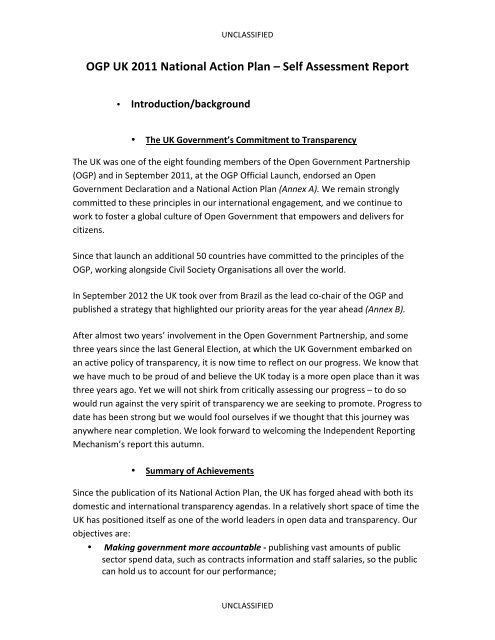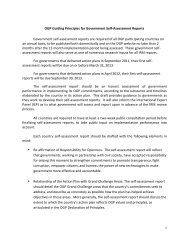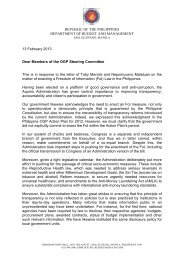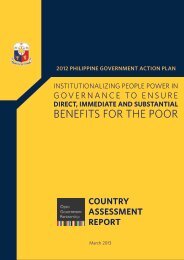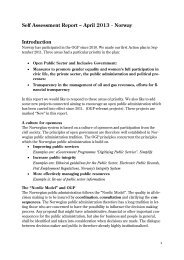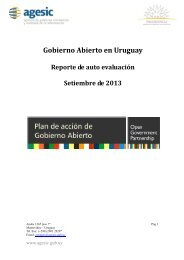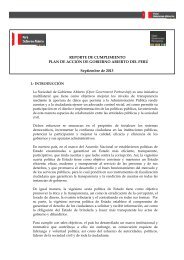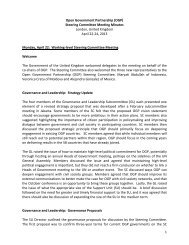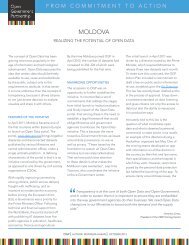Self Assessment Report - Open Government Partnership
Self Assessment Report - Open Government Partnership
Self Assessment Report - Open Government Partnership
Create successful ePaper yourself
Turn your PDF publications into a flip-book with our unique Google optimized e-Paper software.
UNCLASSIFIED<br />
OGP UK 2011 National Action Plan – <strong>Self</strong> <strong>Assessment</strong> <strong>Report</strong> <br />
• Introduction/background <br />
• The UK <strong>Government</strong>’s Commitment to Transparency <br />
The UK was one of the eight founding members of the <strong>Open</strong> <strong>Government</strong> <strong>Partnership</strong> <br />
(OGP) and in September 2011, at the OGP Official Launch, endorsed an <strong>Open</strong> <br />
<strong>Government</strong> Declaration and a National Action Plan (Annex A). We remain strongly <br />
committed to these principles in our international engagement, and we continue to <br />
work to foster a global culture of <strong>Open</strong> <strong>Government</strong> that empowers and delivers for <br />
citizens. <br />
Since that launch an additional 50 countries have committed to the principles of the <br />
OGP, working alongside Civil Society Organisations all over the world. <br />
In September 2012 the UK took over from Brazil as the lead co-‐chair of the OGP and <br />
published a strategy that highlighted our priority areas for the year ahead (Annex B). <br />
After almost two years’ involvement in the <strong>Open</strong> <strong>Government</strong> <strong>Partnership</strong>, and some <br />
three years since the last General Election, at which the UK <strong>Government</strong> embarked on <br />
an active policy of transparency, it is now time to reflect on our progress. We know that <br />
we have much to be proud of and believe the UK today is a more open place than it was <br />
three years ago. Yet we will not shirk from critically assessing our progress – to do so <br />
would run against the very spirit of transparency we are seeking to promote. Progress to <br />
date has been strong but we would fool ourselves if we thought that this journey was <br />
anywhere near completion. We look forward to welcoming the Independent <strong>Report</strong>ing <br />
Mechanism’s report this autumn. <br />
• Summary of Achievements <br />
Since the publication of its National Action Plan, the UK has forged ahead with both its <br />
domestic and international transparency agendas. In a relatively short space of time the <br />
UK has positioned itself as one of the world leaders in open data and transparency. Our <br />
objectives are: <br />
• Making government more accountable -‐ publishing vast amounts of public <br />
sector spend data, such as contracts information and staff salaries, so the public <br />
can hold us to account for our performance; <br />
UNCLASSIFIED
UNCLASSIFIED<br />
• Improving choice in public services -‐ using data to identify best practice, <br />
encourage providers to improve productivity and quality, root out waste and <br />
malpractice, and help citizens make more informed choices; and <br />
• Social and economic growth -‐ using data as a raw material to spur economic <br />
growth by giving businesses data to develop innovative products and services, <br />
opening up new information marketplaces. <br />
Our transparency achievements include: <br />
• Developing and updating a single source, data.gov.uk from which all public data <br />
can be accessed and which now holds over 40,000 files; <br />
• Developing tools so data is available in a variety of open formats; <br />
• Regularly publishing data that allows citizens to hold government to account <br />
over spend, resource and progress -‐ for example: <br />
• All new central government contracts and tenders worth over <br />
£10,000 placed on a single website; <br />
• Placing DFID international development projects over £500 online ; <br />
• Publishing all items of government spend over £25,000; <br />
• Publishing street-‐level crime data to allowing the public to see what <br />
crime has been reported on their streets. With over 47m hits since <br />
inception the site has been developed to show the outcome for each <br />
reported crime, including movement through the justice system; <br />
• Publishing an <strong>Open</strong> Data White Paper that details a strategy for UK <br />
government to ensure all aspects of the public sector are open to <br />
scrutiny and can be accessed by citizens, businesses and civil society <br />
alike; <br />
• Developing and using Public Data Principles so data is not only timely <br />
and high quality, but is also in the most accessible and open formats; <br />
• Developing and publishing an ICT strategy that supports the Public <br />
Data Principles and that establishes core requirements for future <br />
government ICT; and <br />
• Working directly with developers and users of data to enable the <br />
release of the most valuable data. <br />
• Embedding a digital-‐by-‐default approach throughout the government and public <br />
services; and <br />
• Launching gov.uk, a single domain for government information and services. <br />
UNCLASSIFIED
UNCLASSIFIED<br />
• Scope of the self-‐assessment report <br />
This document aims to update on progress. It will also demonstrate how our <br />
transparency agenda has been evolving in the past two years, taking into account new <br />
approaches without deviating from our beliefs and principles. <br />
Annex C gives a detailed account of the level at which each commitment has been <br />
fulfilled and how. There will be a description of lessons learned and plans for the future. <br />
In addition, we have highlighted where commitments to openness and transparency <br />
were either not captured in the plan or were subsequently committed to. <br />
One reflection from this assessment process is that the initial national action plan was <br />
just one dimension of the transparency work across the UK government. Further <br />
commitments to transparency have been made to ensure the agenda moves forward <br />
and that all aspects of transparency and open data work are taken into account. <br />
• The UK involvement in OGP <br />
A commitment to transparency is central to the UK <strong>Government</strong>’s policy agenda. As <br />
Prime Minister, David Cameron, wrote in a letter to Cabinet in July 2011: <br />
“...transparency is at the heart of our agenda for <strong>Government</strong>. We recognise that <br />
transparency and open data can be a powerful tool to help reform public services, foster <br />
innovation and empower citizens. We also understand that transparency can be a <br />
significant driver of economic activity...” <br />
Every department and all Arm’s Length Bodies, share responsibility for the <br />
<strong>Government</strong>'s drive to make public sector organisations more accountable to <br />
citizens. Much has been achieved since we began opening up central <strong>Government</strong> and <br />
the wider public sector, changing the relationship between the citizen and state by <br />
giving people access to data that matters to them. Greater transparency enables <br />
accountability, improves choice, increases public service productivity and quality, and <br />
encourages social and economic growth. <br />
UNCLASSIFIED
UNCLASSIFIED<br />
Another benefit has been to make the processes for driving progress transparent. We <br />
publish the minutes of the Public Sector Transparency Board and other sector specific <br />
boards, (both in traditional form and using interactive new media such as blogs and <br />
tweets); secondly, releasing guides and coding to assist other countries developing open <br />
data agendas. <strong>Open</strong> source coding sits at the heart of the UK agenda, with all coding for <br />
its open data portal and corresponding tools available for others to use or develop <br />
further. <br />
It has been remarkable to see how much the OGP has grown and developed in just over <br />
18 months, but we have even greater expectations and the organisation, which has <br />
widened significantly in a short time, now needs to deepen. By the end of our co-chairmanship<br />
we expect to have: <br />
• Further raised the profile and prestige of the OGP; <br />
• Guided the establishment of the <strong>Partnership</strong> as a sustainable association <br />
with clear objectives, and effective supporting mechanisms; and <br />
• Enhanced engagement with governments, multilateral institutions, civil <br />
society organisations and the private sector. <br />
• Re-‐affirmation of belief in the values and principles of the <br />
partnership <br />
Two years on from the OGP’s establishment, we want to take the opportunity to re-affirm<br />
the <strong>Government</strong>’s strong belief in its principles and values, enshrined in the <br />
UNCLASSIFIED
UNCLASSIFIED<br />
Universal Declaration of Human Rights, the UN Convention Against Corruption, and <br />
other applicable international instruments related to human rights and good <br />
governance. <br />
We confirm our commitments to work with others to: <br />
• Increase the availability of information about governmental activities; <br />
• Support civic participation; <br />
• Implement the highest standards of professional integrity throughout our <br />
administrations; <br />
• Increase access to new technologies for openness and accountability. <br />
• The Process <br />
• How the plan was developed and choice of the OGP “Grand <br />
Challenges” <br />
The UK’s National Action Plan, published in September 2011, was the product of a wider <br />
Transparency Strategy for government, which was intended to be particularly <br />
challenging and stretching, to reflect our OGP commitments. <br />
The Cabinet Office published its <strong>Open</strong> Data Consultation on 4 th August 2011 setting out <br />
proposals for the government’s Transparency and <strong>Open</strong> Data Strategy. The consultation <br />
made a series of proposals aimed at establishing a culture of openness and transparency <br />
in public services. As a result, the focus of UK action fell on the OGP “Grand Challenges” <br />
of “Improving Public Services” and “More Effectively Managing Public Resources”. <br />
• The Commitments <br />
The commitments were formed in three areas <br />
• <strong>Open</strong> Data (Consultation) <br />
• Overseas development aid <br />
• ICT Strategy <br />
UNCLASSIFIED
UNCLASSIFIED<br />
The UK National Action Plan <strong>Open</strong> Data commitments aimed to build on this <br />
government’s established approach to deliver the following high level outcomes: <br />
• accountability <br />
• informed choices <br />
• improved outcomes and quality <br />
• productivity in key services through informed comparison <br />
• transformation of social relationships – empowering individuals and <br />
communities <br />
• dynamic economic growth <br />
• Level of public consultation/Civil Society Engagement <br />
The proposed approach was about creating a ‘pull’ (a right to data) and a ‘push’ (a <br />
presumption of publication). The public consultation lasted three months and asked for <br />
the public’s views on: <br />
• How we might enhance a ‘right to data’, establishing stronger rights for <br />
individuals, businesses and others to obtain data from public service <br />
providers; <br />
• How to set transparency standards that enforce this right to data; <br />
• How public service providers might be held to account for delivering <br />
open data; <br />
• How we might ensure collection and publication of the most useful data; <br />
• How we might make the internal workings of government and the public <br />
sector more open; and <br />
• How far there is a role for government to stimulate enterprise and <br />
market making in the use of open data. <br />
There were 247 written responses to the consultation and a further 217 online <br />
comments via data.gov.uk. Across the responses, there was widespread support for <br />
transparency and open data, though there were divergent views on how ‘<strong>Open</strong> <br />
<strong>Government</strong>’ might be realised. <br />
The Cabinet Office Transparency Team published a government response to the <br />
consultation in January 2012. A formal response was provided in the form of an Annex <br />
in the <strong>Open</strong> Data White Paper, Making <strong>Open</strong> Data Real Consultation (August 2011) <br />
UNCLASSIFIED
UNCLASSIFIED<br />
We have also incorporated user feedback and consultation into our day-‐to-‐day policy <br />
development process and work with government departments to help them release <br />
open data. In 2012 we launched the <strong>Open</strong> Data User Group (ODUG) which is tasked with <br />
prioritising requests received from citizens for the release of specific data, held by the <br />
UK <strong>Government</strong>. This group has an independent Chair who also now sits as a member of <br />
the Public Sector Transparency Board. ODUG has already made some high profile <br />
recommendations to the UK <strong>Government</strong> on which datasets should be released for free <br />
and has collaborated with the Transparency Team to redesign the process by which <br />
datasets are requested by the public and business. <br />
• Implementation of the commitments <br />
The table at Annex C indicates progress to date against the original commitments set <br />
out in the body of the UK plan. The “traffic light” assessment column shows the level of <br />
successful implementation. In summary, through the commitments, the UK has <br />
established channels and opportunities for the community of open data users (and re-users)<br />
to help us identify data that, once released, will contribute to economic and <br />
social growth and foster an environment of innovation. <br />
Annex D similarly provides an update of progress against each of the specific data <br />
commitments that were set out in the annex to the original plan. <br />
The UK <strong>Government</strong>’s commitment is highlighted through the introduction of a <br />
quarterly Written Ministerial Statement (WMS) by the Minister for the Cabinet Office to <br />
Parliament. <br />
Real time tracking of commitments via data.gov.uk also allows for an interactive <br />
visualisation of commitments fulfilled. <br />
Amongst the success stories: <br />
Commitments to High Value <strong>Open</strong> Datasets to support Growth <br />
In Autumn 2011, as part of the Chancellor’s Autumn Statement, the UK <strong>Government</strong> <br />
made a series of world-‐leading commitments to open up public sector data to make <br />
travel easier, healthcare better and create significant growth for industry and jobs in the <br />
UK. The aim was to boost investment in medical research and in digital technology in <br />
the UK, including in many small and medium sized enterprises. These measures were <br />
specifically focused on: <br />
UNCLASSIFIED
UNCLASSIFIED<br />
• Improving medical knowledge and practice with a world-‐first linked-‐data <br />
service to allow healthcare impacts to be tracked, improve medical practice <br />
and put the UK in a prime position for research investment; <br />
• Making business logistics and commuting more efficient through new <br />
releases of data planned on the real-‐time running of trains and buses across <br />
Britain and data on almost every road in Britain for the first time, including <br />
road works; <br />
• Allowing entrepreneurs to develop applications for business and consumers <br />
using the largest volume of open, free high quality data in the world. <br />
<strong>Open</strong>ing up Core Reference Data <br />
In March 2012, the UK <strong>Government</strong> published the terms of reference for new <br />
organisations that ensure the release of open data from some of the most well <br />
respected data producing organisations: the Met Office, Ordnance Survey, Companies <br />
House and Land Registry. The roles were split between the Public Data Group (PDG) as <br />
provider of high value data to <strong>Government</strong>, and the Data Strategy Board (DSB) as <br />
commissioner. The DSB also receives advice on data that should be released with expert <br />
advice provided by the <strong>Open</strong> Data User Group (ODUG). The ODUG has already argued <br />
for the release of certain core reference datasets, and has shown the benefits of <br />
releasing these as <strong>Open</strong> Data. <br />
A world-‐leading <strong>Open</strong> Data White Paper <br />
The UK <strong>Government</strong> published an <strong>Open</strong> Data White Paper in July 2012. The White Paper <br />
set out how government could achieve a transparent society through enhanced access <br />
(to data), building trust (amongst citizens) as well as improving access to meaningful and <br />
re-‐usable data. The paper outlined plans to ensure that the protection of people’s <br />
privacy would remain paramount as government published more data. A privacy expert, <br />
Dame Fiona Caldicott, has been appointed to the Public Sector Transparency Board. The <br />
paper also detailed how government could make better use of the data we hold. It <br />
outlined how we can make progress in both breaking down unnecessary barriers and <br />
creating new ways of working in order to deliver more efficient and effective public <br />
services. <br />
Comprehensive <strong>Open</strong> Data Strategies across central government <br />
UNCLASSIFIED
UNCLASSIFIED<br />
Published in June 2012, the <strong>Open</strong> Data Strategies for each main government <br />
department set out, for the first time, how Departments will embed transparency and <br />
place a presumption to publish at the heart of their business activity. <br />
Each strategy covered five main areas of focus, including the release of anonymised <br />
public datasets; where relevant, individual access to secure personal records (e.g. GP <br />
records); and, greater use and publication of customer insight data. Together with steps <br />
to improve data quality – vital for ensuring the success of <strong>Open</strong> Data – and increased <br />
engagement with data users/reusers, the <strong>Open</strong> Data Strategies are a significant first <br />
step towards truly open government. <br />
The world’s first <strong>Open</strong> Data Institute <br />
In October 2011 the <strong>Government</strong> committed to provide £2m of funding annually over <br />
the next five years to an <strong>Open</strong> Data Institute (ODI), to be matched by an equivalent <br />
amount of funding from outside government. <br />
The ODI is a global first. It works with data owners and data users/consumers to <br />
stimulate the publication and use of open data as well as to deliver training across all <br />
sectors to increase capability. It is independent and not-‐for-‐profit. <br />
DfID: Transparency in International Development <br />
The UK Department for International Development came first out of 72 organisations in <br />
Publish What You Fund’s 2012 Aid Transparency Index. In addition, DFID have <br />
introduced the Aid Transparency Guarantee: ensuring that money spent in development <br />
aid is published in significantly more details so it is fully transparent to citizens both in <br />
the UK and in developing countries. <br />
• Challenges <br />
One of the main criticisms of the UK government agenda from civil society groups has <br />
been the tendency for the transparency agenda to focus on “<strong>Open</strong> Data”, rather than a <br />
broader definition of <strong>Open</strong> <strong>Government</strong>. For this reason, our new National Action Plan <br />
takes a wider view of transparency and its role in driving social and economic growth. <br />
Until recently the transparency agenda has been centrally driven. This has produced <br />
high profile results but with some weaknesses – for example the inability to accurately <br />
assess which releases would have the greatest impact on growth. <br />
UNCLASSIFIED
UNCLASSIFIED<br />
The Public Accounts Committee recently undertook an investigation of the transparency <br />
policy. A number of the committee’s recommendations have already been taken up by <br />
Cabinet Office and are being built into future policy development plans, for example: <br />
• Improving data quality: the re-‐launch of Data.Gov.uk saw a vastly <br />
improved user interface alongside better presentation of data. All <br />
departments agreed to a minimum format standard as part of the <strong>Open</strong> <br />
Data White paper; most are now adhering to it. The Public Data Principles <br />
also provide the foundations for improving data quality; <br />
• Understanding the cost and benefits: Part of the <strong>Open</strong> Data Institute’s <br />
remit is to also look at this issue; <br />
• Understanding the impact on economic growth: The Data Strategy <br />
Board has undertaken a review led by its Chair, Stephan Shakespeare, <br />
and will shortly be publishing its findings, including an independently <br />
commissioned report on understanding the impact of open data and <br />
transparency on the economy; <br />
• Concerns that ‘commercial confidentiality’ will be used as reason for <br />
non-‐publication: Changes to the procurement processes are being driven <br />
centrally and a transparency clause is now included in contractual terms <br />
as standard. Further work is being done to open up transparency around <br />
grants, in particular to civil society organisations so taxpayers can ‘follow <br />
their pounds’; <br />
• Creating a level playing field in terms of transparency: A number of the <br />
original PM commitments were only applied by core government <br />
departments. This was done to get the process right before we widened <br />
the scope to other government organisations. Some organisations are <br />
still exempt from publication, in particular trading funds which compete <br />
with private sector organisations. Publishing requirements are likely to <br />
expand further. <br />
Despite some specific criticisms, the PAC’s report supported the government’s overall <br />
agenda. The issues raised had already been recognised by the <strong>Government</strong> and the <br />
report has helped shape the agenda, giving sharper focus to areas that require greater <br />
attention. <br />
One of the key challenges is to ensure progress with the same pace we have achieved <br />
since 2010. The success of an agenda based on growth depends both on access to open <br />
data and for the data to be used (and citizens to benefit from it). <br />
UNCLASSIFIED
UNCLASSIFIED<br />
<strong>Government</strong> needs to better understand the needs of users, rather than just focusing on <br />
the release of data. This requires a shift from the current practise of ‘pushing’ from the <br />
centre. First steps in this direction have been made through the <strong>Open</strong> Data Institute and <br />
the <strong>Open</strong> Data User Group. In addition to data releases, we must recognise that there <br />
are core skills required to create innovative ways of using the data. ODI’s remit includes <br />
incubation of these skills for established and start up companies/individuals to create <br />
new value from the data being released. <br />
• Conclusions <br />
We are proud of how far the UK government has come in a relatively short space of <br />
time. A key ingredient of our success has been strong political leadership from the start <br />
and recognition that open data is a valuable untapped resource. <br />
Over the past three years the <strong>Government</strong> has worked hard to secure our global <br />
position as a leader in the open government agenda. Yet being at the forefront of such a <br />
challenging agenda carries risks: the most challenging aspect has been maintaining the <br />
balance between progress and an awareness of the potential pressures transparency <br />
can put on government organisations. Key to mitigating these pressures are strong <br />
central guidance and support for organisations to reduce the manual intervention <br />
required in each release. The creation of the transparency governance structure has also <br />
been instrumental in keeping the agenda moving by factoring in the resources and <br />
limitations of each department, to ensure that data publication is achievable by all. <br />
Further pressures are added when looking at the free release of data that has previously <br />
been charged for. This is commonly core data that provides underlying support to a far <br />
wider range of other datasets, for example, ordnance survey information and street <br />
address information. The Data Strategy Board and Public Data Group were formed to <br />
look at this particular issue. Through evidence gathering exercises it will be determined <br />
how and under what terms this high value data is released. The ODI will also feed into <br />
this process to ensure that the data can be released under the best possible terms for <br />
the user. <br />
Following the publication of the action plan, a coalition of civil society organisations <br />
drafted a paper setting out their views on the plan (available at: <br />
http://www.opengovernment.org.uk/civil-‐society-‐perspectives-‐on-‐uk-‐national-‐action-‐plan/) <br />
Their two main criticisms were: <br />
UNCLASSIFIED
UNCLASSIFIED<br />
• The plan was too much/only focused on <strong>Open</strong> Data <br />
• The UK <strong>Government</strong> did not engage with CSOs as effectively as they <br />
wished <br />
As well as these points we have received much positive feedback. At home for example, <br />
the users’ community in particular has appreciated the opportunities provided by our <br />
strategy of <strong>Open</strong> Data release. Internationally, many governments, both OGP <br />
participants and non-‐participants, have sent delegations to London to learn from our <br />
experience. <br />
This <strong>Report</strong> is published in its final version (on www.data.gov.uk, on the Cabinet Office <br />
website, on www.opengovernment.org.uk and on www.opengovpartnership.org) <br />
following two weeks of public consultation. <br />
Thanks to the collaborative approach established with civil society in the past year, the <br />
UK <strong>Government</strong> has been able to address feedback along the way, and this is reflected <br />
in the very limited number of additional comments received during the formal <br />
consultation period. We will ensure that all comments received will be made available <br />
to the Independent <strong>Report</strong>ing Mechanism. <br />
The Cabinet Office Transparency Team has introduced a new approach for the <br />
development of the next action plan by taking engagement and consultation to a higher <br />
level. Officials from the Cabinet Office and other government departments meet weekly <br />
with civil society at the <strong>Open</strong> Data Institute, working side by side to co-‐create our next <br />
National Action Plan with developers, users, businesses and civil society organisations. <br />
National Action Plans are live and developing documents that demonstrate how the <br />
process of opening up government is a journey. So, while we formally close the 2011 <br />
NAP and transition into the new NAP, we also look forward to receiving our first <br />
Independent <strong>Report</strong>ing Mechanism report and commit to working alongside our <br />
domestic and international partners to implement its recommendations; making <br />
changes to the new NAP as necessary to ensure that we are always moving forward with <br />
our agenda. <br />
The publication of a draft of the new plan will be followed by a much wider engagement <br />
process to ensure that the final document, which will be ready by the end of October <br />
2013, will be the result of a more participative and effective consultation. <br />
UNCLASSIFIED


